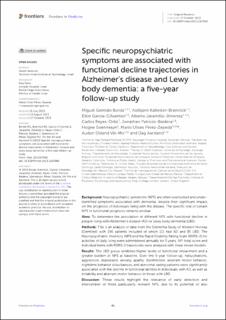| dc.contributor.author | Borda, Miguel Germán | |
| dc.contributor.author | Brønnick, Kolbjørn Kallesten | |
| dc.contributor.author | Garcia-Cifuentes, Elkin | |
| dc.contributor.author | Jaramillo-Jiménez, Alberto | |
| dc.contributor.author | Reyes-Ortiz, Carlos | |
| dc.contributor.author | Patricio-Baldera, Jonathan | |
| dc.contributor.author | Sønnesyn, Hogne | |
| dc.contributor.author | Pérez-Zepeda, Mario Ulises | |
| dc.contributor.author | Vik-Mo, Audun Osland | |
| dc.contributor.author | Aarsland, Dag | |
| dc.date.accessioned | 2024-04-17T13:41:50Z | |
| dc.date.available | 2024-04-17T13:41:50Z | |
| dc.date.created | 2023-11-22T08:36:55Z | |
| dc.date.issued | 2023-10-17 | |
| dc.identifier.issn | 2296-858X | |
| dc.identifier.uri | https://hdl.handle.net/11250/3127087 | |
| dc.description.abstract | Background: Neuropsychiatric symptoms (NPS) are often overlooked and under-identified symptoms associated with dementia, despite their significant impact on the prognosis of individuals living with the disease. The specific role of certain NPS in functional prognosis remains unclear.
Aims: To determine the association of different NPS with functional decline in people living with Alzheimer’s disease (AD) or Lewy body dementia (LBD).
Methods: This is an analysis of data from the Dementia Study of Western Norway (DemVest) with 196 patients included of which 111 had AD and 85 LBD. The Neuropsychiatric Inventory (NPI) and the Rapid Disability Rating Scale (RDRS-2) for activities of daily living were administered annually for 5 years. NPI total score and individual items with RDRS-2 trajectories were analyzed with linear mixed models.
Results: The LBD group exhibited higher levels of functional impairment and a greater burden of NPS at baseline. Over the 5-year follow-up, hallucinations, aggression, depression, anxiety, apathy, disinhibition, aberrant motor behavior, nighttime behavior disturbances, and abnormal eating patterns were significantly associated with the decline in functional abilities in individuals with AD, as well as irritability and aberrant motor behavior in those with LBD.
Discussion: These results highlight the relevance of early detection and intervention of these particularly relevant NPS, due to its potential of also impacting physical function. Better detection and management of these NPS could improve functional prognosis in people living with dementia.
Conclusion: Specific NPS demonstrate relevant distinct associations with Longitudinal trajectories of functional decline in AD and LBD. | en_US |
| dc.language.iso | eng | en_US |
| dc.publisher | Frontiers | en_US |
| dc.rights | Navngivelse 4.0 Internasjonal | * |
| dc.rights.uri | http://creativecommons.org/licenses/by/4.0/deed.no | * |
| dc.title | Specific neuropsychiatric symptoms are associated with functional decline trajectories in Alzheimer’s disease and Lewy body dementia: a five-year follow-up study | en_US |
| dc.type | Journal article | en_US |
| dc.type | Peer reviewed | en_US |
| dc.description.version | publishedVersion | en_US |
| dc.rights.holder | Copyright 2023 the authors | en_US |
| dc.source.articlenumber | 1267060 | en_US |
| cristin.ispublished | true | |
| cristin.fulltext | original | |
| cristin.qualitycode | 1 | |
| dc.identifier.doi | 10.3389/fmed.2023.1267060 | |
| dc.identifier.cristin | 2199984 | |
| dc.source.journal | Frontiers in medicine | en_US |
| dc.identifier.citation | Frontiers in medicine. 2023, 10, 1267060. | en_US |
| dc.source.volume | 10 | en_US |

